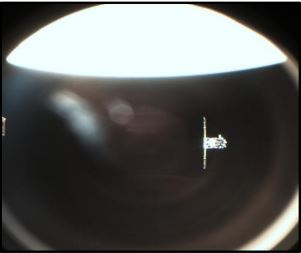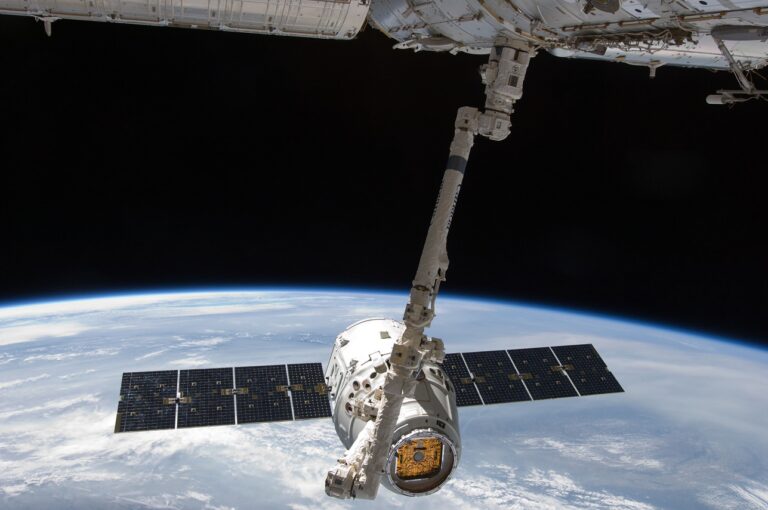Picture: One of the SpaDeX satellites holding position at 15m, CREDIT The Indian Space Research Organisation (ISRO)
On January 16, 2025, India achieved a significant milestone in space exploration by successfully completing its first space docking operation as part of the Space Docking Experiment (SpaDeX). This marks India as the fourth country to demonstrate this capability, following the United States, Russia, and China. The mission highlights the growing sophistication of India’s space technology and its ambitions for advanced in-space operations. This report delves into the technical aspects of the SpaDeX mission, focusing on the devices, systems, and precision involved in achieving this historic feat.
Technical Overview of SpaDeX
The SpaDeX mission utilized two small spacecraft, SDX01 (Chaser) and SDX02 (Target), each weighing approximately 220 kilograms. These spacecraft were deployed into low Earth orbit on December 30, 2024, aboard the Polar Satellite Launch Vehicle (PSLV)-C60. The mission aimed to demonstrate autonomous rendezvous, docking, and post-docking operations, showcasing India’s technological expertise in this critical area.
Key Technologies and Devices
- Docking Mechanism:
- The docking system used in SpaDeX was developed indigenously and incorporated the Bharatiya Docking System. It featured an androgynous design, enabling either spacecraft to act as the active chaser during docking.
- Rendezvous and Docking Sensors:
- The spacecraft were equipped with a suite of four sensors to ensure accurate navigation and alignment:
- Star Sensors: For precise attitude determination using star maps.
- Sun Sensors: To determine the spacecraft’s orientation relative to the Sun.
- Magnetometers: For detecting magnetic fields to assist in orientation.
- Relative Navigation Sensors: For measuring the distance and velocity between the spacecraft.
- The spacecraft were equipped with a suite of four sensors to ensure accurate navigation and alignment:
- Attitude and Orbit Control System (AOCS):
- Included reaction wheels, magnetic torquers, and thrusters to manage the spacecraft’s orientation and position.
- Relative Orbit Determination and Propagation (RODP) Processor:
- A GNSS-based processor for determining the relative position and velocity of the spacecraft with high precision.
- Inter-Satellite Communication Link (ISL):
- Allowed autonomous communication between the two spacecraft, enabling real-time state awareness.
- Power Transfer Technology:
- Enabled the transfer of electrical power between docked spacecraft, a critical capability for future in-space robotics and operations.
- Simulation Test Beds:
- Used for validating hardware and software designs before deployment, ensuring high reliability during mission execution.
Precision and Execution of Docking
The docking process was executed with exceptional accuracy, involving the following stages:
- Rendezvous Maneuver:
- The chaser spacecraft approached the target from a distance of 15 meters to a final hold point at 3 meters.
- The process involved complex orbital adjustments and precise trajectory corrections.
- Docking Execution:
- The docking mechanism initiated with millimeter-level precision to ensure a secure connection between the spacecraft.
- Retraction and rigidization followed, stabilizing the docked configuration for integrated operation.
- Post-Docking Operations:
- The docked spacecraft operated as a single unit, successfully demonstrating electrical power transfer and combined control systems.
Importance of Rendezvous and Docking
Spacecraft rendezvous and docking are foundational technologies for advanced space missions. The SpaDeX mission’s success has several implications:
- Satellite Servicing:
- Enables refueling, repairs, and life extension of satellites, reducing costs and enhancing mission sustainability.
- Space Station Operations:
- Paves the way for modular assembly and maintenance of space stations, such as India’s planned Bharatiya Antariksha Station by 2035.
- Interplanetary Missions:
- Facilitates complex missions requiring multiple spacecraft, such as lunar sample returns and crewed missions to the Moon and Mars.
- Cost-Effective Innovation:
- Demonstrates India’s ability to achieve high-tech milestones at lower costs, making it a competitive player in the global space industry.
Challenges Overcome
The mission faced technical hurdles, including:
- Drift Management: During initial maneuvers, the spacecraft experienced higher-than-expected drift, necessitating precise recalibration.
- Postponements: Initial docking attempts were delayed due to technical issues, underscoring the complexity of the operation.
Despite these challenges, the SpaDeX mission achieved its objectives, reflecting India’s engineering prowess and commitment to advancing space technology.
Conclusion
The SpaDeX mission is a landmark achievement, demonstrating India’s capability in autonomous rendezvous and docking—a critical technology for the future of space exploration. By mastering this capability, India has taken a significant step toward its ambitious goals, including crewed lunar missions, space station operations, and interplanetary exploration. The technical success of SpaDeX not only strengthens India’s position in the global space community but also inspires confidence in its ability to tackle even more complex challenges in the years to come.


